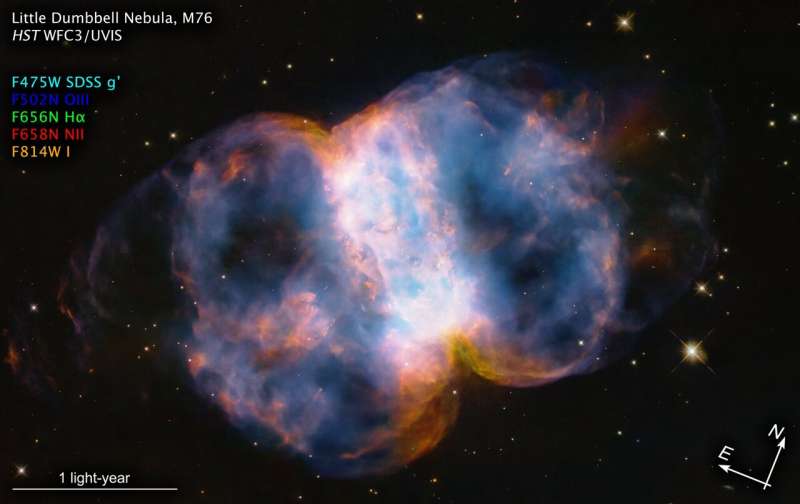This is an annotated Hubble Space Telescope image of the Little Dumbbell Nebula, located 3,400 light-years away in the northern circumpolar constellation Perseus. The object gets its name from its shape, which is a two-lobed structure composed of colorful, mottled, glowing gases that resembles a balloon pinched mid-waist. Like an inflating balloon, the lobes expand into space from a dying star and are seen as a white dot in the center. Intense ultraviolet radiation from super-hot stars causes the gas to glow. Red comes from nitrogen and blue comes from oxygen.Image source: NASA
On April 24, to celebrate the 34th anniversary of the launch of NASA’s legendary Hubble Space Telescope, astronomers took a snapshot of the Little Dumbbell Nebula (also known as Messier 76, M76 or NGC 650/651) located 3,400 light-years away. Polar constellation Perseus. This photogenic nebula is a favorite target of amateur astronomers.
Classified as a planetary nebula, M76 is an expanding shell of glowing gas ejected from a dying red giant star. The star eventually collapses into an ultra-dense and hot white dwarf. Planetary nebulae have nothing to do with planets, but they got their name because astronomers using low-power telescopes in the 1700s thought this type of object resembled a planet.
M76 consists of a ring (a central rod structure when viewed from the side) and two lobes on the two openings of the ring. Before a star burns up, it ejects rings of gas and dust. The ring may have been sculpted by the influence of a star that once had a binary companion.
This shed material forms a thick disk of dust and gas along the plane of the companion’s orbit. The putative companion star is not visible in the Hubble image, so the central star may have later swallowed it. The disk would serve as forensic evidence of stellar cannibalism.
The host star is collapsing to form a white dwarf. It is one of the hottest known stellar remnants, with temperatures reaching 250,000 degrees Fahrenheit, 24 times hotter than the surface of the Sun. The hot white dwarf can be seen as a small dot in the center of the nebula. The stars visible in the projection below it are not part of the nebula.
Two lobes of hot gas trapped by the disk escape from the top and bottom of the “belt” along the star’s axis of rotation perpendicular to the disk. They are driven by hurricane-like outflows of material from dying stars, tearing up space at 2 million miles per hour.
This speed is enough to get from the Earth to the Moon in a little over seven minutes! This turbulent “stellar wind” is rushing in cooler, slower-moving gas that was ejected early in the star’s life, when it was a red giant. Intense ultraviolet radiation from super-hot stars causes the gas to glow. Red comes from nitrogen and blue comes from oxygen.
Given that our solar system is 4.6 billion years old, the entire nebula is a blip in the cosmic clock. It will disappear in about 15,000 years.
Since its launch in 1990, Hubble has made 1.6 million observations of more than 53,000 celestial objects. To date, the Mikulski Space Telescope Archive at the Space Telescope Science Institute in Baltimore, Maryland, has 184 terabytes of processed data available for research and analysis by astronomers around the world.
Since 1990, 44,000 scientific papers based on Hubble observations have been published. This space telescope is the most scientifically productive space astrophysics mission in NASA history. Demand to use Hubble is so high that it is currently oversubscribed by six to one.
Most of Hubble’s discoveries were not anticipated before launch, such as supermassive black holes, the atmospheres of exoplanets, gravitational lensing of dark matter, the presence of dark energy, and massive planet formation in stars.
Hubble will continue research in these areas and use its unique ultraviolet capabilities to study such topics as solar system phenomena, supernova explosions, the composition of exoplanet atmospheres, and the dynamic emission of galaxies. Hubble’s research continues to benefit from its long-baseline observations of solar system objects, stellar phenomena, and other cosmic astrophysics.
NASA’s James Webb Space Telescope is designed to complement the Hubble Telescope, not replace it. Future Hubble studies will also take advantage of synergies with the Webb telescope, which observes the universe in infrared light. The combined wavelength coverage of the two space telescopes expands groundbreaking research in areas such as protostellar disks, exoplanet composition, unusual supernovae, galaxy cores and the chemistry of distant universes.
citation: Hubble Celebrates 34th Anniversary with Observations of the Little Dumbbell Nebula (April 23, 2024) Retrieved April 24, 2024, from https://phys.org/news/2024-04-hubble-celebrates- 34th-anniversary-dumbbell.html
This document is protected by copyright. No part may be reproduced without written permission except in the interests of fair dealing for private study or research purposes. Content is for reference only.
#Hubble #telescope #celebrates #34th #anniversary #observing #Dumbbell #Nebula
Image Source : phys.org
